


THE EXPANSION OF THE AZTEC EMPIRE UNDER ITZCOATL 1432 (H6)
xxxxxAs we have seen (1325 E2), having moved southwards into the valley of Mexico around 1120, the Aztecs, a very industrious people, quickly took control of their immediate area and set up their capital at Tenochtitlan. By 1432, under their leader Itzcoatl, they were the dominant power in central Mexico and, by the death of their great leader Montezuma I in 1468, their empire stretched from the Atlantic to the Pacific. Power lay with the high priests, and thousands of animals and humans were sacrificed each year to placate their gods, such as the sun or moon. The empire, made up of hundreds of small states, was kept together by sheer force, and maintained by a remarkable system of intense farming. Huge stepped pyramids were built as temples, and many large cities were established. The Aztecs developed their own form of pictorial writing, gained a deep understanding of astronomy, and produced some fine textiles, pottery and jewellery. However, there was little loyalty shown towards the leader and, as we shall see, when the Spaniards arrived in 1519 (H8), the Empire was quickly and quite easily subdued.
aaaaaLegend has it, as we have seen (1325 E2), that in about 1120 the Aztecs moved southwards into the valley of Mexico on the advice of their god Huitzilopochtli (Humming Wizard). An industrious farming and hunting people, they quickly subdued the Toltecs, and then took control of the weaker tribes around them. It was probably in 1325 that they began reclaiming a marshy island near the western edge of Lake Texcoco. Here they built their capital Tenochtitlan (place of the high priest Tenoch) and consolidated their hold on the area.
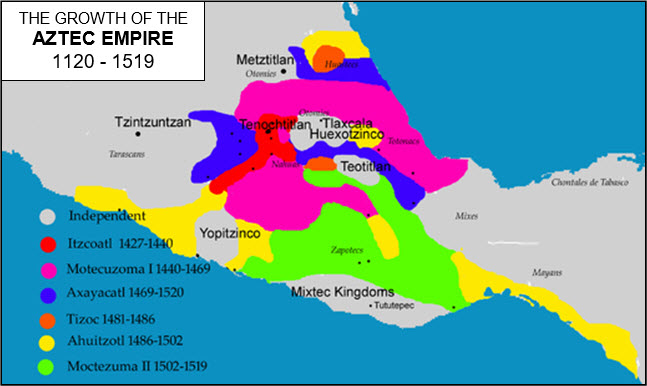 aaaaaIn these early years, the Aztecs were very much under the overall control of Azcapotzalco, the largest of the city-
aaaaaIn these early years, the Aztecs were very much under the overall control of Azcapotzalco, the largest of the city-
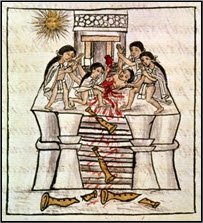 aaaaaThe Aztec empire was governed by a king, but the real power lay with the high priests, all coming from the ruling families. It was they who communed with their Gods -
aaaaaThe Aztec empire was governed by a king, but the real power lay with the high priests, all coming from the ruling families. It was they who communed with their Gods -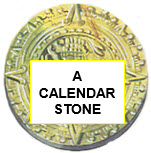 to the Gods. Victims would be killed by arrows, flayed alive, or ripped open so that their hearts could be offered up as nourishment for the sun god (
to the Gods. Victims would be killed by arrows, flayed alive, or ripped open so that their hearts could be offered up as nourishment for the sun god (
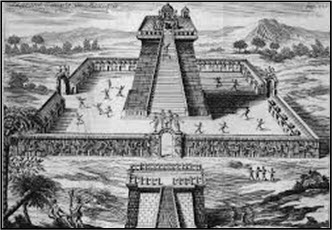 aaaaaThe empire itself -
aaaaaThe empire itself -
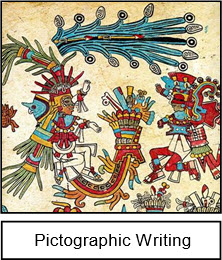 aaaaaAt its height, the Aztecs could boast of an advanced civilisation, despite restrictions imposed by its isolated position. Schools were established for the nobles and priests, and for the teaching of martial arts. A form of pictographic writing was developed, written on animal hide, to record such matters as royal history, astrological predictions, the payment of tribute, and the quantity of food supplies held in store. Huge stepped pyramids were erected to house their temples, and a string of large cities was developed across the empire. A special artisan class produced elaborate stone figures, textiles, mosaics, pottery and fine jewellery in gold, jade and turquoise.
aaaaaAt its height, the Aztecs could boast of an advanced civilisation, despite restrictions imposed by its isolated position. Schools were established for the nobles and priests, and for the teaching of martial arts. A form of pictographic writing was developed, written on animal hide, to record such matters as royal history, astrological predictions, the payment of tribute, and the quantity of food supplies held in store. Huge stepped pyramids were erected to house their temples, and a string of large cities was developed across the empire. A special artisan class produced elaborate stone figures, textiles, mosaics, pottery and fine jewellery in gold, jade and turquoise.
aaaaaBut despite the size and success of this empire, it had two major flaws. Firstly, its leader was appointed by the Gods. If he were to be forcibly removed, then the whole structure and fabric of the state would be thrown into confusion and could well collapse like a pack of cards. Secondly, the empire was made up of a mass of loosely connected urban communities, held together by force. Loyalty was a very scarce commodity! As we shall see, when the Spaniards arrived in 1519 (H8), these subject city-
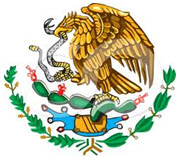
 aaaaaIt is rather difficult to explain how the Aztecs, a poor nomadic people coming from the north, surrounded by hostile tribes, and obliged to settle in a marshy island in the middle of a lake, managed to make so powerful an empire in the space of two centuries. Perhaps it was due to the Aztecs’ fervent belief in their own destiny. As mentioned earlier, it was on the advice of their God “Humming Wizard” that they moved into the valley of Mexico in the first place. According to legend, they were then told that they would found a great civilisation on a particular area of marshland where they would find a cactus growing out of a rock and, perched on this cactus, an eagle eating a snake. We can only assume that the priests found this spot when they arrived at Lake Texcoco! But whether they did or not, the cactus, the eagle and the snake appear on all Mexican money today, and on the country’s coat of arms. And the name Mexico comes from the Aztec word for the area, Mexica.
aaaaaIt is rather difficult to explain how the Aztecs, a poor nomadic people coming from the north, surrounded by hostile tribes, and obliged to settle in a marshy island in the middle of a lake, managed to make so powerful an empire in the space of two centuries. Perhaps it was due to the Aztecs’ fervent belief in their own destiny. As mentioned earlier, it was on the advice of their God “Humming Wizard” that they moved into the valley of Mexico in the first place. According to legend, they were then told that they would found a great civilisation on a particular area of marshland where they would find a cactus growing out of a rock and, perched on this cactus, an eagle eating a snake. We can only assume that the priests found this spot when they arrived at Lake Texcoco! But whether they did or not, the cactus, the eagle and the snake appear on all Mexican money today, and on the country’s coat of arms. And the name Mexico comes from the Aztec word for the area, Mexica.
aaaaaIncidentally, when the Great Temple of Tenochtitlan was inaugurated in 1487 it is estimated that some 20,000 men, women and children were ritually sacrificed.



Acknowledgements
Map (Mexico): licensed under Creative Commons. Author: enwiki/Maunus -
H6-